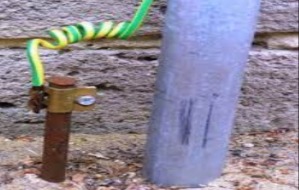
As a homeowner, I know you have heard the electrical term ground wire, and also have them on your major appliances and outlets. But did you know their role in home electrical safety?
This article will teach you all you need to know about electric earth wires, and its roles in home safety.
What is an electrical ground wire?
A ground wire is a conductor, mostly copper wire, used in the electrical system to send faulty currents to the ground. It helps to prevent the risk of electric shock, fire outbreak, and damage to electrical devices.
What does a grounding wire do?
A grounding cable serves as a safe route for excess electricity to follow if there is a power surge or a short circuit.
Normally, electrical wires come with 3 wires, one hot, one neutral, and a ground wire. Currents flow from the source to appliances through the hot wires, and return to the source via the neutral wire.
If a fault occurs, such as a damaged wire or a loose connection, currents leak from the hot wire to the metal frame of the appliance.
When this happens, the ground wire provides a safer path for the current to flow to the ground. This sudden rise in current trips the circuit breaker, preventing electrical hazards.
Importance of Grounding in Electrical Systems
Apart from providing a safe path for faulty currents to flow into the earth, grounding also plays some other crucial roles. These include:
Electrical shock absorber
Excess electrical charges are common in every home. They can arise from lightning strikes, big appliance start-ups and loose connections.
If your home has some ungrounded outlets, the surge may cause some damage, including electrocution. But if your earthing system is proper, it will safely absorb the charges.
Prevents electric shock
Grounding wire provides a safe path for stray currents to flow to the earth instead of the human body. This reduces the risk of electric shocks.
Reduces the risk of fire outbreaks
Damaged and faulty wiring can cause sparks and overheating, leading to fires. Grounding diverts these dangerous currents from flammable materials, preventing electrical fires from starting.
Protects electrical equipment
Electrical surges and spikes can damage sensitive components in an appliance, but grounding acts as a voltage regulator, by absorbing excess electricity.
Compliance with electrical code
Proper grounding is mandatory in most electrical codes and safety standards, ensuring the electrical system meets legal requirements.
What needs to be grounded?
Your home wiring system is built with this grounding system as part of modern electrical safety codes. Most of your appliances and electronic devices have this form of protection.
All 3 prong appliances and tools need to be grounded and should be connected to outlets with grounding capabilities.
On the other hand, devices without 3 prongs have some double insulation that reduce their chances of short circuits.
If your house was built before or around 1960s, there may possibility your house is not grounded. This also applies to any electrical work done by non-professionals or work that does not meet the standard requirements.
This is why it is always advisable to hire a professional electrician for all home electrical upgrades.
How to Test for Electrical Grounding
You can test your home’s electrical system to see if it is properly grounded with a multimeter. Here are the steps:
- Set the multimeter dial to AC voltage mode.
- Touch the red probe to the hot slot and the black probe to the neutral slot of the socket. Note the voltage reading.
- Then, touch the black probe to the ground prong while keeping the red probe on the hot slot.
- The voltage reading should be close to zero if the outlet is properly grounded. A significant difference indicates a grounding issue.
When to call an electrician
If you are not conversant with electrical installation, it is always advisable to call an electrician.
Mariaelectricals is always here to serve you, our electricians are certified and we will complete all our work with the safety code in mind.
Related articles
- How to Wire a Light Switch.
- How to wire a Circuit Breaker Box
- How to Replace a Bad Circuit Breaker
- 3 Way Switch Wiring / How to Wire 3-Way switches
- 4 Way Switch Wiring Diagrams / How to Wire a 4-Way Switch.
- Doorbell Wiring Diagrams: Learn How to install a doorbell Transformer, Chime, and Push Button